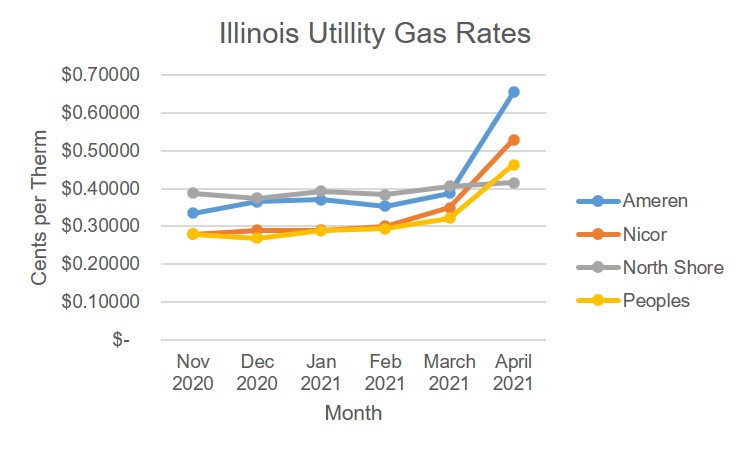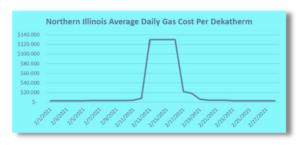ILLINOIS UTILITY GAS RATES JUMP IN APRIL 2021
For the month of April 2021, three of the four largest Illinois gas utilities again increased the price customers (who buy gas from their ng utility) will be charged substantially from where their rates were in prior months. Although March 2021 rates were also higher than February (the previous month), April’s jump is substantially larger.
Illinois natural gas utilities “Natural Gas Cost Rates” include the price utilities anticipate to pay to purchase gas in the wholesale market, including the costs of transportation and storage services, and any reconciliation from prior months. These charges can vary from month to month. Gas utilities do not profit from the price of gas; it must be passed on to consumers without markup.
As was discussed in IRMA’s previous Energy Update, “The Impacts of February’s Colder Than Normal Temperatures”, February’s below normal temperatures increased demand for natural gas while the supply of natural gas was decreasing. This combined effect forced the utilities to buy gas in the spot market at higher than normal prices to meet their customers’ higher than anticipated demand. Since the gas utilities set their rates at the beginning of the month, any deviations from expectations are built into future months’ rates.

Even though natural gas is now trading at levels close to where it was prior to February, the utilities have raised their rates. Since the utilities pass through their full cost to acquire gas for customers and use various buying strategies, their rates don’t always reflect what is happening in the market. Due to the utilities buying strategies and the need to balance over/under collected positions, utility gas rates can move counter to current market conditions.
The rate charged by the utilities in February didn’t change during the month even though their costs to acquire additional gas during February exceeded February’s monthly gas rates. It wasn’t until March and now continuing in April that the utilities are recovering the excess February gas cost. How long the utilities’ rates remain comparatively high depends on how quickly their revenue shortage is recovered. As we move into the non-heating season months, gas usage/demand will go down. The reduced volume required for non-heating months may keep the utilities gas rate high for several months to come.
FIXED RATE OPTIONS: The IRMA energy team has worked with many members to help them secure a fixed gas rate through an alternative retail supplier. If you are currently buying your gas supply from your utility and would like to see what your fixed rate options are, please reach out to the IRMA Energy team.


